More than ever, your MacOS computer needs protection, so the question arises: How to Install SentinelOne with Token on MacOS With SentinelOne as an all-in-one solution to security, you can be assured that a wide array of harmful software will be detected in real-time, whether malware or ransomware. Though the installation of SentinelOne on MacOS was not expected to be a difficult step, people variously describe it.
This guide wrote to now show you 10 different implementation methods at the start.
Table of Contents
Method 1: Using the SentinelOne Management Console

- Log in to the SentinelOne Management Console.
- Navigate to the ‘Installations’ tab.
- Generate a token for your macOS deployment.
- Download the macOS installer from the console.
- Open the installer package and follow the on-screen instructions.
- Enter the generated token when prompted to complete the installation.
Method 2: Command Line Installation

- Open Terminal on your macOS device.
- Download the installer package using the `curl` command.
“`sh
curl -O https://example.com/sentinelone.dmg
“`
- Mount the disk image.
“`sh
hdiutil attach sentinelone.dmg
“`
- Run the installer.
“`sh
sudo installer -pkg /Volumes/SentinelOne/SentinelOne.pkg -target /
“`
- Enter the token when prompted.
Method 3: Apple Remote Desktop

- Open Apple Remote Desktop on your admin device.
- Add the target macOS devices to the list.
- Distribute the SentinelOne installer package to the target devices.
- Run a remote shell script to install SentinelOne on all devices.
- Enter the token during the installation process.
Method 4: Mobile Device Management (MDM)

- Add SentinelOne installer package to your MDM server.
- Create a policy for macOS devices.
- Upload the token and configure the installer settings.
- Deploy the policy to the enrolled macOS devices.
- Verify installation through the MDM dashboard.
Method 5: Manual Installation via USB

- Copy the SentinelOne installer to a USB drive.
- Insert the USB drive into the target macOS device.
- Open the installer package from the USB drive.
- Follow the on-screen instructions to install SentinelOne.
- Enter the token when prompted.
Method 6: Automated Script

- Write a shell script to automate the installation process.
“`sh
#!/bin/bash
curl -O https://example.com/sentinelone.dmg
hdiutil attach sentinelone.dmg
sudo installer -pkg /Volumes/SentinelOne/SentinelOne.pkg -target /
echo “Enter token:”
read token
sudo /usr/local/bin/sentinelctl activate -t $token
“`
- Save the script and make it executable.
“`sh
chmod +x install_sentinelone.sh
“`
- Run the script on the target macOS device.
Method 7: Using JAMF Pro

- Log in to JAMF Pro console.
- Upload the SentinelOne installer package.
- Create a policy for deployment.
- Add a script to enter the token during installation.
- Deploy the policy to the target macOS devices.
Method 8: Using Munki

- Add the SentinelOne installer to your Munki repository.
- Create a manifest for the macOS devices.
- Configure the installer settings to include the token.
- Deploy the manifest to the target devices.
- Verify the installation through the Munki dashboard.
Method 9: Using Ansible

- Install Ansible on your control machine.
- Write a playbook for installing SentinelOne.
“`yaml
—
- hosts: macos
tasks:
- name: Download SentinelOne installer package
- name: Mount the disk image
- name: Install SentinelOne
- name: Activate SentinelOne
- Run the playbook.
- Install Chef on your workstation.
- Write a cookbook for installing SentinelOne.
- Run the cookbook on the target macOS devices.
Conclusion
Installation of SentinelOne on macOS devices is straightforward, as various methods have been specially developed for various scenarios. Whether through the Management Console, command line, or automatically via scripted methods, there is a method to suit your every need. Following the above steps will ensure that advanced security features from SentinelOne are embedded in your MacOS devices.
Ready to supercharge your system with the security your business needs? Choose what matches your setup best, and start with an installation today!
Want to read more articles like this ? Click here.


